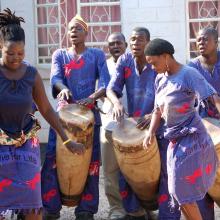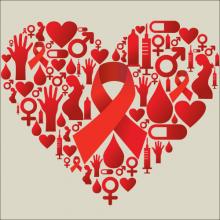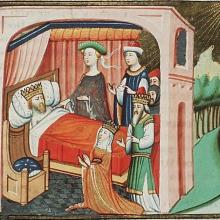HIV
As is still the case today, bipartisan programs take effort — and bringing PEPFAR to life was no small feat. It required navigating a host of controversial issues such as the use of condoms and perceptions of the disease. It required enlisting the support of social conservatives. It required making an economic, a national security, and a humanitarian argument. It required raising awareness and galvanizing political will.
Ashon T. Crawley, author, artist, and professor of religious studies and African American and African studies at the University of Virginia, constructed a memorial for Black church choir directors who died during the U.S. HIV/AIDS crisis. The exhibit, “HOMEGOING,” told the story of the musicians who, as he puts it, “died within a kind of epistemological moment,” where to be a musician in the Black church was to be understood as gay, to be gay was to be understood as HIV-positive, and vice versa.
In many ways, Seele and countless others who forged the Black church’s response to HIV/AIDS laid the foundation for an effective and powerful faith-based response to COVID-19.
IN 1985, WHEN Jesse Milan Jr. was in his late 20s, no one from his Philadelphia church attended his partner’s funeral. Not because they refused, but because Milan didn’t invite them. Doing so would have required him to say what he felt uncomfortable sharing: He loved a man who had HIV. He is a man who has HIV.
“This is never going to happen to me again,” Milan vowed to himself at the funeral, regarding the loneliness he felt because he didn’t draw close his church family at one of the most painful moments of his life.
Milan is now the president and CEO of AIDS United, an organization fighting the HIV epidemic in the U.S. He is adamant that no one in the HIV community be isolated from the love and support they need. “People living with HIV,” said Milan, “have a longing to belong. A longing to be cared for and a longing to not be silent or secret.”
A lifelong Episcopalian, Milan grew up in a congregation in the Diocese of Kansas, following the example of his mother and father in serving their spiritual home and, in times of need, allowing their siblings in Christ to serve them. Milan kept this mutuality in mind when he enrolled at Princeton University and, struggling to transition from public school and homesick for his church, joined the Episcopal Church at Princeton. It was, Milan told Sojourners, “an anchor, a port to tap into on a regular basis whenever I needed it.”
Helping communities live
FOR MANY PEOPLE today, the closest we get to understanding the impact of HIV/AIDS in the 1980s and early ’90s is through stage and screen portrayals such as Pose, Angels in America, and Rent. For others, the memories and losses of that time are vivid and unforgettable.
For instance, Jesse Peel, a gay psychiatrist and community organizer, documented in his journals the avoidance and terror of HIV that overtook his home city, Atlanta, and the nation. As many people rapidly contracted and died of the disease, doctors struggled to understand what was happening and many nurses refused to bring meals into the hospital rooms of the stricken, Peel wrote in documents he donated to a collection at Emory University. By 1994, AIDS was the leading cause of death for Americans age 25 to 44. It killed more than 350,000 people in the country between 1981 and 1995.
“I think the experience of people who are of a certain age will always be colored by our experience of the death and the dying,” said Milan. “Today, I sense that [younger] people’s commitment to HIV/AIDS work is more about the rights and the inequalities that are manifested in HIV and AIDS. They have a broad lens about where human rights need to advance, and that broad lens includes the trans community and all others.”
In the early years of the epidemic, many pastors and religious people publicly denounced and turned their backs on HIV-positive people. Others embraced those who were suffering, opening care programs and advocating for government funding. Reminding the nation’s leaders of their responsibility to the HIV community is a job that’s been done by many Christians and is a significant part of AIDS United’s history and present work.
Faith and Reform
Writer and social reform Harriet Beecher Stowe’s controversial 1852 novel Uncle Tom’s Cabin brought many people to the anti-slavery movement. In Harriet Beecher Stowe: A Spiritual Life, biographer Nancy Koester illuminates the shifting role and expression of faith in Stowe’s personal and public life and work. Wm. B. Eerdmans
Falling into Love
A few years ago a young man named Rocky Braat left Pittsburgh to wander India; he’s ended up working for years in an orphanage for HIV-positive children there. His friend, filmmaker Steve Hoover, went to explore why. The result is a Sundance-award-winning documentary, Blood Brother. www.bloodbrotherfilm.com
At prayer healing services in some Pentecostal churches, pastors invite people infected with HIV to come forward for a public healing, after which they burn the person’s anti-retroviral medications and declare the person cured.
The “cure” is not free, and some people say they shell out their life savings to receive a miracle blessing and quit taking the drugs.
“I believe people can be healed of all kinds of sickness, including HIV, through prayers,” said Pastor Joseph Maina of Agmo Prayer Mountain, a Pentecostal church on the outskirts of Nairobi. “We usually guide them. We don’t ask for money, but we ask them to leave some seed money that they please.”
But the controversial ceremonies are raising red flags as believers’ conditions worsen, and a debate has opened over whether science or religion should take the lead in the fight against the AIDS epidemic.
During the past 30 years, the AIDS pandemic has provided an unfortunate opportunity to follow God’s call to care for the widow and orphan. Husbands succumb to illness, leaving behind wives and children who also carry the disease. Mothers die, leaving behind children without care, and too often is the case that those children — who could have avoided in utero transmission of HIV with proper medical care — also die. Entire families are lost.
This Sunday marks the 25th anniversary of World AIDS Day. This day is not simply about wearing a red ribbon to show solidarity in the fight against AIDS. Instead, it is an opportunity to address the tough issues presented by HIV, such as how those disproportionately affected by the disease mirror society’s most marginalized populations — the poor and women — and how faith-based communities can best serve those populations.
We are making historic progress against HIV/AIDS: The global rate of new HIV infections has leveled, and the number of annual AIDS deaths has decreased by nearly a third since 2005. Antiretroviral drugs are driving these gains by stopping progression of the disease and, we now know, preventing the spread of HIV infections.
Yet AIDS remains the leading cause of death in sub-Saharan Africa, where poverty limits access to lifesaving treatments and 25 million people are living with HIV—representing 70 percent of cases worldwide. President Barack Obama should be commended for uniting the world behind the goal of creating an AIDS-free generation. I share his passion and believe we can achieve this in the next decade — but only if we accelerate the provision of antiretrovirals to the poorest and most vulnerable people.
The opportunity has never been clearer. New data published in the New England Journal of Medicine project that early treatment with antiretrovirals in South Africa, my home country, would prove very cost-effective over a lifetime (costing $590 per life-year saved) and generate both public health and economic benefits. The World Health Organization now recommends early and preventive treatment with antiretrovirals, including administration to children and uninfected partners of people living with the disease. The WHO estimates that this could save an additional 3 million lives and prevent at least as many new HIV infections through 2025.
When Obama and I met in South Africa in June, I reminded him that, given his deep familial roots in the continent, his success is our success — his failure, our failure. With that in mind, there are two decisions Obama can make before the end of this year to fulfill the promise of an AIDS-free generation.
I am not shy about using the saltshaker, and neither I nor anyone else in my family has any sort of problem with blood pressure. That’s because we mostly don’t eat things that come out of packages or from fast-food places (where someone else takes them out of packages), and the salt that is a problem in the North American diet doesn’t come from the saltshaker but from the extreme levels of sodium in packaged foods.
But you will never hear Michelle Obama say that.
There was a similar unutterability to everything having to do with AIDS back in the day. Even when scientists had a fairly clear understanding of the nature of the threat and how it was spread, most “official” speech tended toward a hedging: “we don’t know what causes it; we don’t want to say what’s causing it …” Even today people don’t get tested because they don’t want to know, even though getting tested obviously doesn’t give you the virus — it merely points out that it is there. It seems to point to so much more, though.
The Global Fund has a plan to win the fight against the three major diseases of poverty—and it's working.
Look for a billboard on the right and a sign on your left. There’s a dirt road. Turn there.
In this part of the world, most of the streets have no names. So the directions we were given to find the new compound where my son’s Malawian relatives relocated a few months earlier were pretty specific given the circumstances.
We had hoped to be able to visit with Vasco’s 16-year-old half-brother, Juma, his Aunt Esme, and a handful of cousins and other relations for a couple of hours. By the time we found the family’s new compound, we had less than an hour before we had to get back on the road, meet the rest of our traveling companions, and head north before the sun fell.
I was heartbroken. But when we pulled up in our van, Vasco’s relatives were so happy to see us (and vice versa) that even the woefully short visit felt richly blessed. It had been three years since we’d seen each other. The last time was in May 2010 when Vasco, my husband, and I traveled from California to Blantyre for our adoption hearing. We spent a month in Blantyre and were able to get to know Vasco’s extended family (or, sadly, what remains of it) and begin piecing together our son’s complicated biography.
Since our last visit, Vasco, now 13, has grown about a foot and then some. He’s also traded his close-cropped “Obama cut” for Bob Marley-esque locks. Vasco wasn’t the only one who’d changed – visibly and otherwise.
Malawi is one of the poorest countries on the planet, with more than 9 million people living on about $1.25 a day. HIV/AIDS, which we believe claimed the lives of Vasco’s birth parents before he would have entered kindergarten, remains a critical health issue. Among 15- to 49-year-olds, the HIV/AIDS rate hovers above 10 percent despite widespread efforts to combat the fully preventable disease.
Malaria, tuberculosis, and diarrhea-related fatalities remain high in Malawi. So does unemployment, particularly among younger workers in urban areas such as Blantyre, where it is approximately 70 percent.
Bio: Executive director of Sexual Minorities Uganda, which works for full legal and social equality in the country, and recipient of the 2011 Robert F. Kennedy Human Rights Award. www.sexualminoritiesuganda.net
1. What’s your response to the letter U.S. religious leaders signed last year, which condemned the “Anti-Homosexuality Bill” before Uganda’s Parliament because it “would forcefully push lesbian, gay, bisexual, and transgender (LGBT) people further into the margins”?
Uganda is a very Christian country. About 85 percent of our population is Christian—Anglican, Catholic, and Pentecostal. So for religious leaders to speak out against the Ugandan legislation, that is very important for me and for my colleagues in Uganda, because it speaks not only to the politicians and legislators, but also to the minds of the ordinary citizens.
It is very important to have respected religious leaders involved, including Archbishop Desmond Tutu, because these are leaders who have spoken out on other human rights issues such as apartheid, women’s rights, and slavery. And for us, for the voice of LGBT rights, to join with these other issues clearly indicates that our movement is fighting for human rights.
On my desk, next to my laptop, is a can of seltzer water. My grapefruit-flavored, bubbly water sits about four inches away from my left hand as I write. When the can is empty, I might take another from the fridge or fill up a water bottle at the kitchen sink.
Water drives my day, but I rarely think about it. I cook pasta in it. I heat water to make tea. I fill a bucket to mop the floor and a draw a bath with hot water and soak in it. At the moment, my dishwasher is growling away, and I’m waiting to hear the pleasant beep that alerts me that the clothes in the washer downstairs are clean.
I’ve never considered water a women’s issue. Not until this past week, that is. On Friday, the day before World AIDS Day 2012, I had the privilege of attending World Vision’s Strong Women, Strong World luncheon in New York City. Strong Women, Strong World is a new initiative “supporting sustainable change in some of the difficult places in the world to be a girl or a woman.” The focus of the day was water.
The Honorable Melanne Verveer, U.S. Ambassador at-large for Global Women’s Issues, spoke at the event. She celebrated the progress humanitarian organizations such as World Vision have made in the effort to eradicate HIV/AIDS, but reminded us that the number of people living with HIV is at an all-time high. In 2010, HIV/AIDS killed 1.8 million people. Sixty percent of those living with HIV are girls and women, and AIDS is the leading cause of death of women of reproductive age (15-44 years old) globally.
“HIV,” Ambassador Verveer said, “has the face of a woman.”
As people of faith, it is not uncommon to pray for miracles when faced with overwhelming obstacles. For many of us, AIDS has been one of those mind-boggling, heart-wrenching causes that has wreaked havoc on the world and been the subject of many prayers.
Since the early days of the disease, the focus has been on a cure. Researchers worked tirelessly for it and the faithful asked God to provide it. But the cure has never come.
And yet, as we mark another AIDS Day this Saturday, Dec. 1, there is evidence of the miraculous.
After 24 years of commemorating this day with grim statistics and little hope, there is finally good news.
Millions of people are receiving treatment. Many fewer people are dying.
The new infection rate has dropped by 50 percent or more in 25 countries since 2001. With access to treatment, being HIV-positive is now considered a chronic disease, not a fatal one.
NAIROBI, Kenya -- Church leaders are pressing the Kenyan government to scientifically test herbal medicines that are used by millions to manage and treat diseases, saying the nontraditional therapies could be putting patients' health at risk.
The leaders say HIV/AIDS patients and others suffering chronic conditions are widely using the medicines, whose efficacy is unknown.
Speak out for those who cannot speak,
for the rights of all the destitute.
Speak out, judge righteously,
defend the rights of the poor and needy.
~ Proverbs 31:8-9
ADDIS ABABA — These words of King Solomon have been running through my mind since our ONE Moms delegation — 13 mothers from the United States, the United Kingdom, and France — arrived in the Ethiopian capital on Sunday.
I hear these verses as a clarion call to action. As someone who strives humbly to follow the Way of Jesus and be involved in The Work that God is doing in the world, I want to respond and do what these verses command.
And as a believer who also happens to be a mother (a fairly novice one, still learning the ropes, if you will), I must do.
Sunday afternoon, after us ONE Moms dropped our luggage at the hotel, piled into our chartered bus, and drove to the outskirts of the city to the Mary Joy Aid Through Development Association, we met our Ethiopian sisters who are speaking out for those who cannot; who are advocating on behalf of the destitute, judging with righteous wisdom, and defending the rights of the poor and the needy.
For the second time in Chicago this year, the life of a gender-variant young person of color was lost to violence.
Donta Gooden’s body was found in an abandoned building on the city’s West Side late in the evening of August 14th. Gooden, 19, who also went by the name “Tiffany,” was stabbed to death just three blocks from where Paige Clay, a 23 year-old transgender woman, was shot and killed in April, according to media reports. The police investigation is ongoing.
The tragedy of these senseless killings, still so raw and heartrending for the loved ones of Gooden and Clay, is beyond comprehension and deplorable on every level. But perhaps even more unsettling is how often violent crimes against LGBTQ people occur and how little social outrage they ignite.
For many, these two terrible tragedies may melt into the background in a year when Chicago is scrambling to stem a rising tide of murder across the city (year -to-date homicides are up 25 percent from August 2011 according to data compiled by the Redeye. However, they are part of an alarming trend of violence targeting LGBTQ people of color – and transgender and gender-variant people of color in particular – which directly intersects with the front lines of the HIV epidemic.
I wonder what would happen if the daily barrage of negative, misleading political campaign ads were replaced just for a day by a one-minute clip from the opening ceremony of the International AIDS Conference in Washington, D.C., last week.
This replacement ad would feature a beautiful, regal woman from Nigeria sharing a heartfelt and poignant ‘thank you’ to the American people for literally saving her life by providing access to antiretroviral drugs — medicine that creates a modern-day “Lazarus effect” in people whose immune systems have been ravaged by AIDS — and also ensures that her daughter was born HIV-free. I wish every member of Congress could have heard these words, a ‘thank you’ that echoes what many nations in sub-Saharan Africa are experiencing as they work to turn the tide of this deadly disease.
This one mother and child from Nigeria are only a snapshot of the millions of lives that have been transformed by American generosity and leadership through life-saving investments in the President's Emergency Plan For AIDS Relief (PEPFAR) and the Global Fund to Fight AIDS, TB and Malaria — which have increased the number of Africans on treatment from a shameful 50,000 in 2002 to more than 4 million today.
It’s a rare place of worship where Muslims and Baha’is both congregate, and where prayer rugs share space with a silver cross, religious pamphlets on healing in Hebrew, and a bright scarlet AIDS bow. But on Wednesday afternoon, that was the scene at the Interfaith Prayer Room of the AIDS 2012 conference.
“This room is designed for Muslims, Christians, Hindus, Jews, Baha’is — for anyone who needs to find a place for quiet and prayer, and counseling, if necessary,” said Imam Dr. Abdul-Malik Ali, who just finished leading prayers beside a broad banner reading “Faith in Action — End Stigma Now.”
A sign in English, French, Spanish, and Arabic welcomed worshippers to the carpeted prayer room. Double doors cut the clamor of thousands of convention-goers to a murmur, so that inside, even the faintest clicking of the ventilation system was audible. To complete the contrast with the outside’s roar and bustle, the air was cool and the lights were gently dimmed.
In the 31 years since the discovery of HIV and AIDS, nearly 30 million people have died from the virus with 34 million people currently living with the disease.
The epidemic is at its worst in sub-Saharan Africa, and women are affected the most. In fact, 59 percent of people living with HIV and AIDS in sub-Saharan Africa are women.
Statistics like these are mind-numbing. Though necessary, they can nearly cripple our response as they point to the inefficacy of our actions.
This is why, when I teach or write on HIV and AIDS, I prefer to tell stories. And as people of faith, we need stories, both ancient and new, to help us navigate our response to social issues such as HIV and AIDS.

















